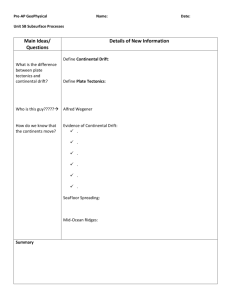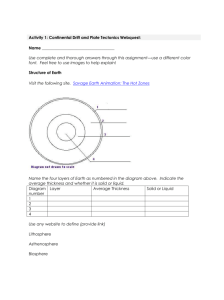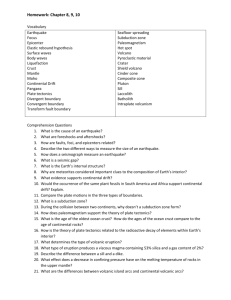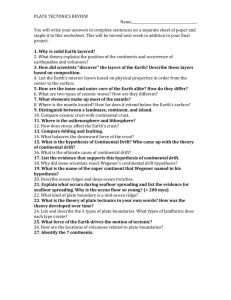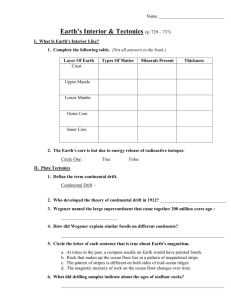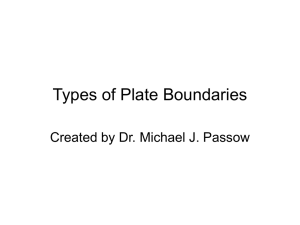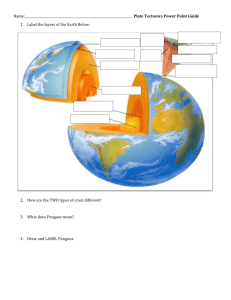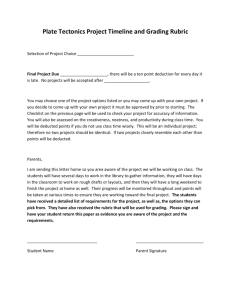Continental Drift and Plate Tectonics
advertisement
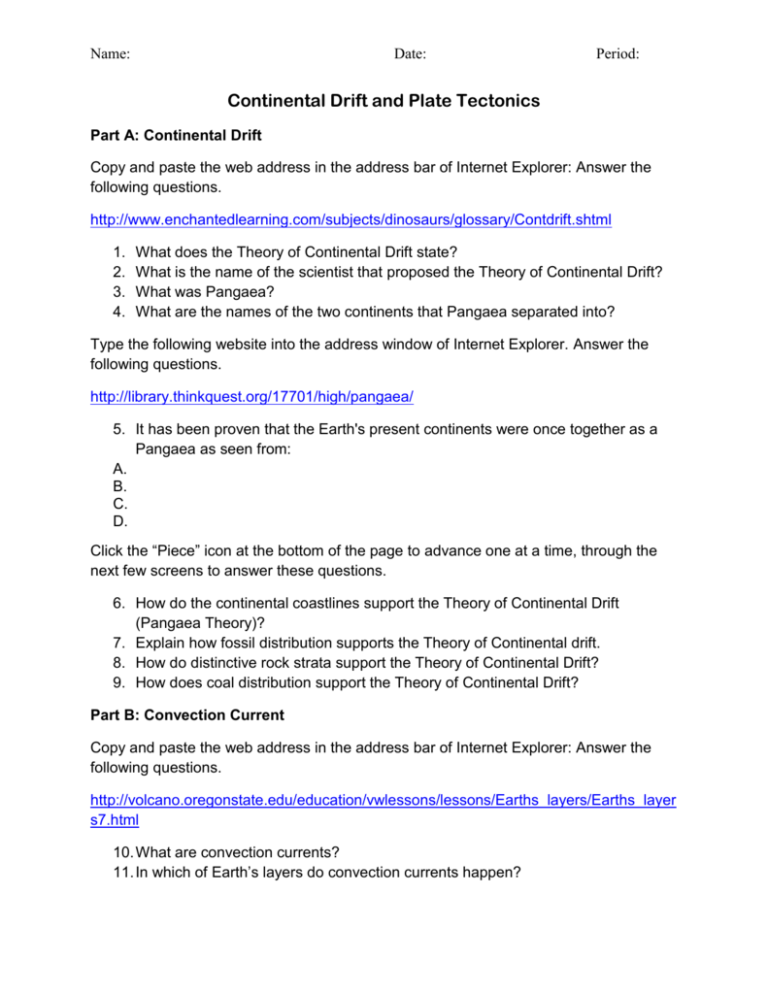
Name: Date: Period: Continental Drift and Plate Tectonics Part A: Continental Drift Copy and paste the web address in the address bar of Internet Explorer: Answer the following questions. http://www.enchantedlearning.com/subjects/dinosaurs/glossary/Contdrift.shtml 1. 2. 3. 4. What does the Theory of Continental Drift state? What is the name of the scientist that proposed the Theory of Continental Drift? What was Pangaea? What are the names of the two continents that Pangaea separated into? Type the following website into the address window of Internet Explorer. Answer the following questions. http://library.thinkquest.org/17701/high/pangaea/ 5. It has been proven that the Earth's present continents were once together as a Pangaea as seen from: A. B. C. D. Click the “Piece” icon at the bottom of the page to advance one at a time, through the next few screens to answer these questions. 6. How do the continental coastlines support the Theory of Continental Drift (Pangaea Theory)? 7. Explain how fossil distribution supports the Theory of Continental drift. 8. How do distinctive rock strata support the Theory of Continental Drift? 9. How does coal distribution support the Theory of Continental Drift? Part B: Convection Current Copy and paste the web address in the address bar of Internet Explorer: Answer the following questions. http://volcano.oregonstate.edu/education/vwlessons/lessons/Earths_layers/Earths_layer s7.html 10. What are convection currents? 11. In which of Earth’s layers do convection currents happen? Name: Date: Period: 12. When convection currents flow in the mantle, they also move the ____________. Part C: Plate Tectonics Copy and paste the web address in the address bar of Internet Explorer. Click on the “Historical Perspective” icon on this website: Answer the following questions. http://pubs.usgs.gov/gip/dynamic/dynamic.html 13. What is a “plate” in geological terms? 14. What does the Theory of Plate Tectonics state? 15. What is the name of the theory that led to the development of the Theory of Plate Tectonics? Click the back arrow of Internet Explorer to return to the homepage of http://pubs.usgs.gov/gip/dynamic/dynamic.html. Click on the “Understanding Plate Motions” icon on this website. 16. What are the four types of plate boundaries? a. __________________________________________________________ b. __________________________________________________________ c. __________________________________________________________ d. __________________________________________________________ Click on Illustration of the Main Types of Plate Boundaries and label the diagram.17–21 Answer Answer Answer Answer Answer Name: Date: Period: Part D: Plate Tectonics: Types of Boundaries: Divergent boundaries Click the back arrow once on the Internet Explorer screen to move back one page. Scroll down to Divergent Boundaries. Finish the following sentence: 22. Divergent boundaries occur along spreading centers where ___________________ are moving __________________ and new crust is created by _________________ pushing up from the _________________. Click on the link: Mid-Atlantic Ridge 23. What is shown in this picture? 24. What type of plate boundary is it? 25. Where is it located? Part E: Plate Tectonics: Types of Boundaries: Convergent Boundaries Scroll down to: Convergent Boundaries. 26. What is the location where sinking of a plate occurs is called? 27. The type of convergence -- called by some a very slow "collision" -- that takes place between plates depends on the kind of lithosphere involved. Convergence can occur between what types of plates? a. b. c. Scroll down to: Oceanic-continental convergence 28. Off the coast of South America along the Peru-Chile trench, the oceanic Nazca Plate is pushing into and being subducted under the continental part of the South American Plate creating what? Look at the diagram under the Oceanic-continental convergence information: Label the following diagram. 29 – 35 Name: Date: Answer Answer Answer Click on the Ring of Fire 36. What is the ring of fire? 37. The Ring of fire results in frequent what? Period: Answer Answer Name: Date: Period: 38. The West coast of the United States has frequent volcanoes, use the ring of fire to explain why. Part E: Plate Tectonics: Types of Boundaries: Convergent Boundaries continued Scroll down to Oceanic-Oceanic convergence 39. When two oceanic plates converge, one is usually subducted under the other what is formed? Scroll down to: Continental-continental convergence 40. What mountain range demonstrates one of the most visible and spectacular consequences of plate tectonics? 41. What happens when two continents meet head-on, meet head-on and neither is subducted? Look at the diagram under the Continental-continental information: Label diagram. 42-47 Answer Answer Answer Answer Part F: Plate Tectonics: Types of Boundaries: Transform Boundary Scroll down to: Transform Boundaries: 48. The zone between two plates sliding horizontally past one another is called a transform-fault boundary, or simply a ____________________________ _____________________________. Name: Date: Click on the diagram San Andreas fault: 49. The picture is an aerial view of what? 50. Make three observations about the picture 51. What type of boundary does it results from? Period:

